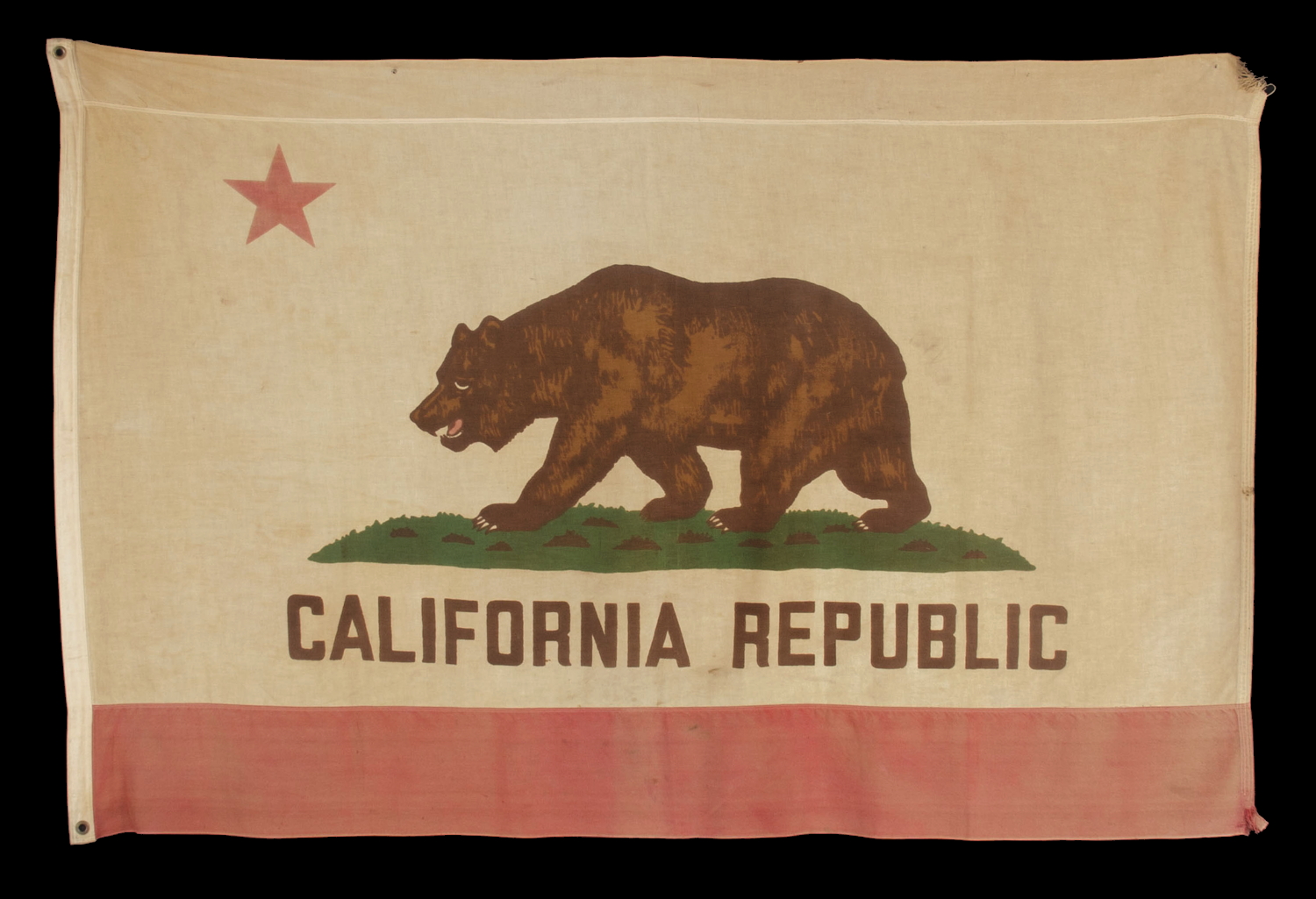
| |
VINTAGE CALIFORNIA STATE FLAG, CA 1940-1960's |
|
| Available: |
Sold |
| Frame Size (H x L): |
|
| Flag Size (H x L): |
45" x 68.5" |
|
| Description....: |
|
Early state flags fall between very scarce and extraordinarily rare in the antiques marketplace. One primary reason for this is that most states, even if they existed during the 18th or 19th century, didn’t actually adopt flags until the early 20th century. The Maryland State Legislature, for example, didn’t find need for a state banner until 1904, in spite of the fact that Maryland was one of the original 13 colonies. Other states had crests or symbols that were tied to the state legislature in some way, or to local patriotism, but didn't accept an official design until many years following statehood.
In the case of California, the "Bear Flag," as all California state flags and variations thereof are often called, is based on a significant early example. The eldest of these is thought to date to the 1846 “Bear Flag Revolt,” which occurred when Major John Fremont arrived in the state on a so-called mission to reach the Pacific and encouraged an uprising against Mexican rule in the territory. Fremont claimed himself military governor of the California Republic and was brought up on charges of treason for his actions, but was pardoned by President James Polk. Polk was an expansionist and Fremont’s actions brought California to statehood in 1850, immediately following the 1849 Gold Rush.
The original Bear Flag was designed and made by William L. Todd, a first cousin to Abraham Lincoln’s wife, Mary Todd. Painted on cotton, it had a white field with a red stripe along the bottom, just the like modern design. The star image was taken from what was known as the “California Lone Star Flag”, flown during California's previous, 1836 revolt. Like the modern California flag, the red star appeared the upper hoist-end corner, but the bear—orange in color—was small, placed next to the star, and was standing. On the modern design it is black and brown, centered on the field, prominently huge, and walking. On Todd’s flag, the words “California Republic” were likewise in black, but the letters spanned the width of the star and bear images and were placed immediately below them. Today they are underneath the large bear, just above the red bar.
Unfortunately, the original Bear Flag was destroyed in the fires following the 1906 San Francisco earthquake, but an image of it survives in a photograph, taken in 1890.
The bear flag did not become the official California state flag, however, until it was adopted by the California State Legislature and signed into law by Governor Hiram Johnson in 1911. States were regularly participating in World’s Fair events by this time—popular between the late 19th and mid 20th centuries—and were probably compelled to create state banners because other states had them, so it would have seemed improper not to obtain one and follow suit.
Because state flags are desired by modern antiques enthusiasts and because early copies are scarce or non-existent, I am sometimes compelled to acquire interesting vintage examples from the mid-20th century. This ca 1940-60 era California “bear flag” is a nice example, obviously flown and slightly soiled from use.
Construction: The flag is made of cotton bunting, sewn in three panels, two of them white to form the top register and one red to form the lower. These are pieced by machine. The imagery is printed in four colors. There is a cotton binding along the hoist, sewn by machine, with two brass grommets.
Mounting: The flag has not yet been mounted. Please be aware that we have a full time conservation staff that can properly mount the flag for an additional charge. This would involve hand-stitching it to 100% silk organza for support, then hand-sewing it to a background of your choice, with a supportive backboard with a wooden strainer frame behind. The flag can be hung on this mount without framing, but the mount also prepares the flag for framing.
Condition: There is significant fading and oxidation throughout and there is some minor soiling. There are looses from obvious use at the top at bottom corners of the fly end, accompanied by a couple of tiny holes along the top edge. Many of my clients prefer flags to show their age and history of use. |
|
|
|
| Collector Level: |
Beginners and Holiday Gift Giving |
|
| Flag Type: |
Sewn flag |
|
| Star Count: |
|
|
| Earliest Date of Origin: |
1940 |
|
| Latest Date of Origin: |
1960 |
|
| State/Affiliation: |
California |
|
| War Association: |
|
|
| Price: |
SOLD |
|
| |
Views: 9089 |
|
|
|

